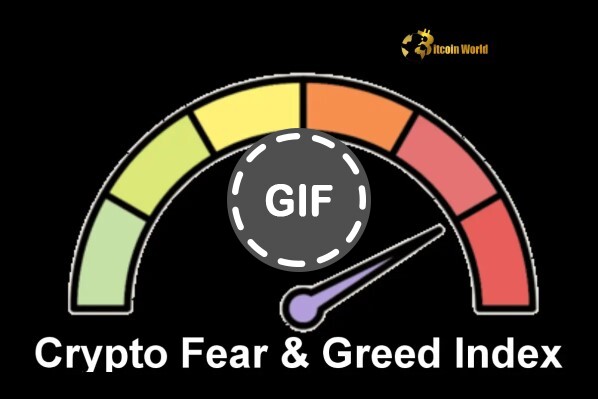BitcoinWorld

Decoding the Crypto Fear and Greed Index: Market Sentiment Remains Greed
The world of cryptocurrency is a dynamic landscape, heavily influenced by the collective mood of investors and traders. Understanding this underlying emotional state – whether people are feeling fearful and hesitant or greedy and eager – is crucial for navigating the market. A widely used tool for gauging this is the Crypto Fear and Greed Index.
Recently, this popular indicator, provided by software development platform Alternative, registered a value of 57 as of June 5. This figure marks a five-point decrease from the previous day’s reading. While this drop indicates a slight cooling of market enthusiasm, the index firmly places the current crypto market sentiment within the ‘Greed’ territory.
Understanding the Crypto Fear and Greed Index: More Than Just a Number
The index operates on a simple yet insightful principle: extreme fear can be a sign that investors are overly worried, potentially presenting a buying opportunity, while extreme greed suggests the market might be due for a correction as investors become complacent or overly speculative. The index scale ranges from 0 to 100:
- 0-24: Extreme Fear – Investors are very worried. Could signal a potential bottom.
- 25-49: Fear – Market is nervous. Caution is prevalent.
- 50-74: Greed – Market is optimistic. Prices are rising, attracting more buyers.
- 75-100: Extreme Greed – Market is overheated. FOMO (Fear Of Missing Out) is high. Could signal a potential top.
The index doesn’t rely on just one data point. Instead, it aggregates data from several key sources, each weighted differently, to provide a comprehensive snapshot of market psychology.
What Drives Crypto Market Sentiment? The Index Factors Explained
The calculation of the index is based on six distinct factors, though one is currently paused. Each factor offers a unique perspective on the market’s mood:
- Volatility (25%): This measures the current volatility and maximum drawdown of Bitcoin compared to its average values over the last 30 and 90 days. High crypto volatility, especially sharp downward moves, often signals fear in the market. Conversely, stable or upward-trending prices with lower volatility can contribute to a sense of greed or confidence.
- Market Momentum/Volume (25%): This component compares the current market volume and momentum (strength of price movements) with the average values over the last 30 and 90 days. High buying volume on upward trends indicates strong Market momentum driven by investor interest and often signals greed. Low volume or high selling volume on downward trends suggests fear or lack of conviction.
- Social Media (15%): The index analyzes posts on various social media platforms, focusing on specific hashtags related to Bitcoin and other cryptocurrencies. It counts the speed and frequency of posts and assesses the sentiment (positive or negative) of these interactions. High levels of positive discussion and engagement can boost the greed score.
- Surveys (15%): (Currently Paused) While not active at the moment, this factor historically involved weekly polls where users were asked about their perception of the market. This provided a direct measure of investor sentiment, bypassing market data analysis.
- Bitcoin Dominance (10%): This metric tracks Bitcoin’s share of the total cryptocurrency market capitalization. An increase in Bitcoin dominance often suggests that investors are moving funds out of altcoins and into Bitcoin, which is typically seen as a safer haven in crypto. This can indicate fear. Conversely, decreasing dominance often means money is flowing into altcoins, a sign of higher risk appetite and potentially greed.
- Google Trends (10%): By analyzing search query data related to Bitcoin and other cryptocurrencies on Google Trends, the index can gauge public interest and sentiment. For example, a sudden surge in searches for terms like “Bitcoin price prediction” or “buy crypto” might indicate growing public greed, while searches for “Bitcoin scam” or “crypto crash” could signal fear.
By combining these factors, the index provides a nuanced perspective that goes beyond simple price movements.
Current State: Why 57 Still Signals Greed
A reading of 57, while lower than the previous day, still falls comfortably within the ‘Greed’ zone (50-74). This suggests that despite some recent price fluctuations or potentially cautious news, the prevailing mood among crypto investors remains optimistic. The slight drop might reflect short-term price dips, minor negative news cycles, or profit-taking, but it hasn’t been significant enough to push the overall sentiment back into ‘Fear’.
Being in the ‘Greed’ phase means that investors are generally confident, willing to buy, and perhaps chasing upward price trends. This positive sentiment can create a self-reinforcing cycle, pushing prices higher as more people jump in.
Navigating a ‘Greed’ Market: Opportunities and Risks
When the Crypto Fear and Greed Index is in the ‘Greed’ zone, several market dynamics are typically at play:
- Opportunities: Continued upward price action is possible as positive sentiment fuels buying. Altcoins may perform well as risk appetite increases (reflected in potentially decreasing Bitcoin dominance). Traders might find opportunities in riding upward trends, leveraging the positive Market momentum.
- Risks: The primary risk in a ‘Greed’ market is overheating. Prices can become overextended, driven more by emotion and FOMO than fundamentals. This increases the potential for sharp corrections. High Crypto volatility can work both ways, leading to rapid losses if sentiment suddenly shifts. It’s crucial to avoid getting swept up in the hype and making impulsive decisions based solely on positive sentiment.
Limitations of the Crypto Fear and Greed Index: It’s Not a Crystal Ball
While a valuable tool for understanding current crypto market sentiment, the index has limitations:
- Lagging Indicator: The index reflects the *current* sentiment based on recent data. It doesn’t predict future price movements with certainty.
- Correlation vs. Causation: While high greed often correlates with market tops and high fear with market bottoms, the index doesn’t *cause* these events. It reflects the collective behavior that drives them.
- Simplified View: Market dynamics are complex. The index provides a useful summary but doesn’t capture all nuances, such as specific sector performance or regulatory news impacts.
Using the Index: Actionable Insights for Your Strategy
How can you use the Crypto Fear and Greed Index effectively?
- As a Contrarian Signal: Some experienced traders use the index contrarianly – considering buying when the index is in ‘Extreme Fear’ (when others are panicking) and considering selling or taking profits when it’s in ‘Extreme Greed’ (when others are overly confident).
- As a Confirmation Tool: Use the index to confirm signals from your other analysis methods (technical, fundamental). If your analysis suggests a potential uptrend and the index is in ‘Greed’, it might reinforce the positive outlook driven by Market momentum. If your analysis suggests caution and the index is in ‘Extreme Greed’, it adds weight to the potential for a pullback.
- Understand the Context: Always look at *why* the index is at a certain level. Are all factors pointing in the same direction, or is one factor like high Crypto volatility pulling it down while others remain positive? Consider the role of Bitcoin dominance in the overall picture.
- Manage Risk: Regardless of the index level, always employ sound risk management practices. Don’t invest more than you can afford to lose, and consider setting stop-loss orders.
Conclusion
The Crypto Fear and Greed Index, currently sitting at 57 and indicating ‘Greed’, remains a valuable barometer for understanding the prevailing mood in the cryptocurrency market. While it has dipped slightly, the sentiment is still largely optimistic, driven by factors like market momentum, social media trends, and potentially Bitcoin dominance dynamics. By understanding how this index works and its components, and by using it in conjunction with other analytical tools, investors can gain better insights into the emotional forces shaping the market, helping them make more informed decisions rather than being solely guided by fear or greed themselves.
To learn more about the latest crypto market trends, explore our articles on key developments shaping cryptocurrency price action.
This post Decoding the Crypto Fear and Greed Index: Market Sentiment Remains Greed first appeared on BitcoinWorld and is written by Editorial Team





